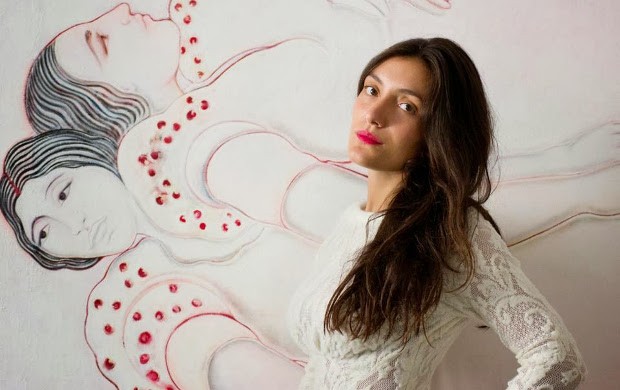Why do you label your style “figurative-symbolic”?
In my painting everything seems to emerge from the world of dreams. The viewer has no reference points, definitions or real landscapes to grasp on to. The dialogue I establish with each work is unique and personal and the only metre you can use to judge the work is the emotion and the way in which it manifests itself.
My painting is “symbolic” in as much as it is unreal and intimate. I treat the shapes and forms in my works as if they were abstract; there’s a kind of obsessive repetition. Also, the figures and their gestures are symbolic but the symbolism isn’t prescribed; it comes from the unconscious. The figures in my works are closed shapes, round, and take on essential forms.
The works are all untitled because I don’t want the world of words and definitions to disturb the painting and the viewer’s experience, which should be pure, direct and not require words.
What inspires you?
Anywhere my eyes rest can be inspiration! Throughout my life I have developed an addiction to beauty—the movement of hands, almonds, flour, meringues, Sicilian baroque, Byzantine mosaics, the islands of the Mediterranean, shells, statues from ancient Greece, volcanoes, town squares, peonies, the great Italian film directors from the post-war period, Mascagni’s music, Picasso, Balthus, Hockney, Giotto, my studio…
The list could go on forever. Everything that moves me and my emotions deeply is inspiring.
What does being creative mean to you?
Creativity is freedom and courage to understand that if we are present in the moment we can change our lives.
The creative finds a different way to interpret our times. Inventing new ways and new worlds in order to find another ‘vision’, where anything is possible and limitations are pushed aside. Reality is not passively received, it is recreated sublimely; it is reinvented.
What kind of rituals and routines to do you have when it comes to your work?
I drink a coffee, walk my dogs, open my eyes in front of a white wall, close them, reopen them and then I pick up painting wherever it was I left off the evening before.
What is your favourite piece you have created?
The work I’m most fond of is the white bathers that went to the 54th Venice Biennale in 2011. I made it in my old studio in London back in 2010.
What creative medium would you like to use, but haven’t yet?
I would like to make a new series of works using ceramics. I think that white ceramics could be a perfect material for my subjects…
Why do you paint your women suspended in air?
I don’t usually explain my paintings, but the suspended women are somewhere in a psychological/metaphysical timeless space. Maybe because the things deepest inside of me are suspended.
These women are looking at each other and supporting each other. Even when they look at each other it is as if they are looking at themselves as they look similar to each other.
Do you think your style has change in the last year or so?
I don’t think my style has changed much over the years. I work with oil so the process is quite slow and is made up of many layers of material, which renders the figures sculptural like fossils or shells. Then there are the works I have done on packaging paper, which are much quicker and more gestural. They are pictorial drawings.
What are your aspirations for the future?
In the future I want my works to travel the world and come into contact with many different types of viewers.
And I’d like to have studios in different locations so that I could make my works in those locations, such as M’hamid, a small town that is one of the gates to the Sahara desert. Or on a volcanic island like Stromboli in Sicily…or Mexico City. Seeing as people often see a connection between my work and Mexico! Or an igloo near the North Pole.
You exhibited in the Venice Biennale Pavilion in 2014, what did you think of it?
The Venice Biennale is a unique and intense experience. Of course I’d like to be invited back with a new project.
Which 20th century painters interest and influence you?
There are so many artists that I love from the 20th century, but above all Pablo Picasso, Toulouse Lautrec, Matisse, Balthus, Marc Chagalle, Francis Bacon, Morandi, David Hockney, Pino Jelo, and then Cy Twombly, Rothko, Mario Schifano, Louise Bourgeois, Pino Pascali, Lucian Freud, Felice Casorati, Alighieri Boetti… just for a start!
Where does your art begin, how personal are your works to you?
My work definitely starts with me; it’s an intimate work about self-observation. My subjects, such as flowers and figures, are a reflection of my way of seeing and translating reality.
Where does your creativity come from?
I grew up in a family where art always filled our home. My father is a classical music composer and since I was small he has always said to me that art passes through through the heart first. The emotion is immediate, then the mind follows more slowly with its reflections.
Would you consider painting men, rather than just women?
If it’s instinctive. I don’t put any brakes on representation in my work. But for now I think I still have a lot to say about the female world and so I’m concentrating on that.










